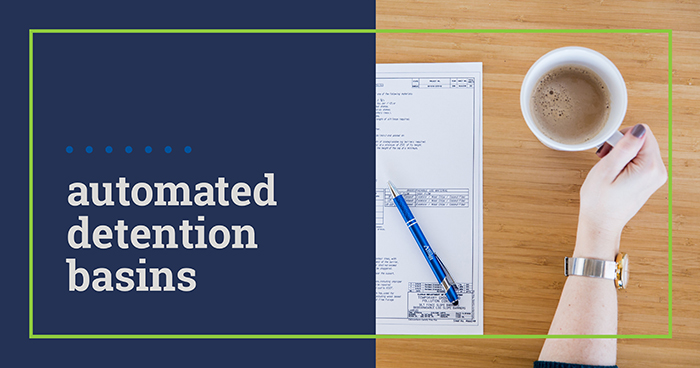Automated Detention Basins: A Look at RTC, CMAC and What’s Next
Posted on Wednesday, April 27th, 2022 by Affinis CorpIn Stormwater, tagged in

The introduction of “smart” technologies into stormwater management is a concept that has been gaining traction around the world in recent years (García et al. 2015; Mullapudi et al. 2017; Schütze et al. 2004; Shishegar et al. 2018). A promising form of smart stormwater management is Real Time Control (RTC). Through internet connected sensors and actuators (such as motorized valves and pumps), RTC allows for runoff to be stored in basins long enough to relieve pressure from other parts of the drainage system.
The real time control idea has been around for a long time. Originally, real time control meant that an operator must be on site to manually close valves or gates to control the release of stored water. This was a workable, low-cost option for sites requiring only occasional control. A more advanced way is using technology to control the valves and gates remotely, so you do not need an operator on site. While this method was convenient, it still needs an operator and is subject to human error. Lately, basin owners started using RTC, which involves replacing the operator with a computer program that has a set of rules that can make real time decisions, analyze data obtained by the system, and communicate with other systems.
Generally, dry, wet, and extended detention basins operate with an outlet structure that releases certain flow regardless of the condition of the rest of the drainage system (maintaining certain water level in the basin). The RTC technology uses real time monitoring and outlet controls to provide basin owners with a greater ability to manage discharges, water levels, and storage capacity in real time to maximize the flood control and water quality benefits of the basin.
Here, in our backyard, the City of Lenexa, Kansas and the Johnson County Stormwater Management Program (SMP) used the Continuous Monitoring and Adaptive Control (CMAC) system to retrofit the exiting outlet structures on serval ponds in 2016. Their goal was to improve water quality while increasing flood control capacity. CMAC was installed on the following:
- Coon Creek Ponds: Outlet retrofit to release stormwater before forecasted storms
- Coon Creek North and South: Outlet retrofit to adjust release timing and watershed area to maximize benefit of facilities in the same watershed
- City Center: Outlet retrofit to allow stormwater to fill the pond above the permanent pool and release after the retention period.
The sewer program of Kansas City, Missouri also adopted the CMAC system. In 2017, the city used this system to control a million gallon dry detention stormwater basin that discharges to the combined sewer system. Prior to using CMAC, city staff had to manually close and open the storm water gate before and after anticipated storm events.
While the localized RTC are well established, through retrofit of existing structures, the scaled system control of watersheds is not widely used yet. Studies are being done to show how a smart stormwater system can be leveraged to shape streamflow within an urban watershed by coordinating release from computer-controlled stormwater basins to achieve desired control objectives downstream. (Shaping Streamflow Using a Real-Time Stormwater Control Network, Abhiram Mullapudi, Brandon Wong, University of Michigan, 2018)
Possibilities are unlimited when it comes to stormwater systems real time control. Research is being done on urban stormwater systems positioning and evaluating a series of real time sensor and actuator networks in partnership with stormwater management districts, municipalities, and cities developing a cyber infrastructure to provide real time sensor readings and real time hydraulic models to inform operations and enable the real time control of stormwater assets all the way to the rivers.